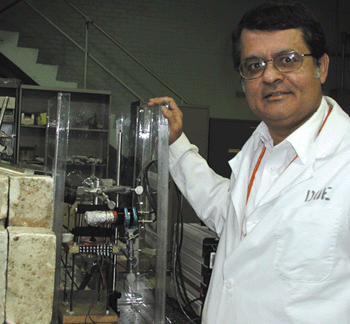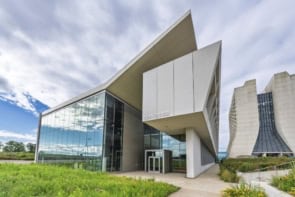Physicists in the US claim to have seen nuclear fusion in a table-top experiment but their work has met with a hostile reaction from other researchers.

When Rusi Taleyarkhan of the Oak Ridge National Laboratory and colleagues reported last month that they had observed evidence for nuclear fusion in a beaker of deuterated acetone, controversy was sure to follow. The researchers claimed to have detected neutrons and tritium when bubbles in the acetone collapsed to generate temperatures of millions of degrees in sonoluminescence or “sound-into-light” experiments (R Taleyarkhan et al. 2002 Science 295 1868).
However, other physicists at Oak Ridge have failed to reproduce the results, and many researchers in the field have voiced doubts about the experiment as well. Some are worried that the incident will prove to be a repeat of the discredited “cold fusion” claims in the late-1980s, but they all agree that “bubble fusion” would be a major discovery if it proves to be real.
Let there be light – and fusion?
In sonoluminescence, flashes of light are emitted by bubbles that are forced to expand and then collapse by sound waves, although this process is still not fully understood (see Physics World May 1998 pp38-42, print version). Physicists have long speculated that the considerable compression forces inside the collapsing bubbles could be large enough to spark nuclear reactions. If this was the case, it could lead to a new source of clean energy.
In their experiment, Taleyarkhan and co-workers at Oak Ridge, the Rensselaer Polytechnic Institute in the US, and the Russian Academy of Sciences used 14 MeV neutrons to create bubbles about 10 nanometres across in acetone in which the ordinary hydrogen atoms had been replaced by deuterium atoms (C3D6O). An acoustic signal then forced these bubbles – and the acetone vapour inside them – to first expand to about a millimetre in size, and then collapse.
Two deuterium nuclei can fuse to produce either a tritium nucleus and a proton, or a helium-3 nucleus and a neutron with an energy of 2.45 MeV. Taleyarkhan and co-workers claim to have seen evidence for both tritium and 2.45 MeV neutrons in their experiments. They have also calculated that temperatures of a million or even 10 million degrees – the temperature at the Sun’s core – must have existed inside the bubbles for these reactions to proceed.
Given the highly surprising nature of the results, the Oak Ridge management asked two other physicists – Dan Shapira and Michael Saltmarsh – to repeat the experiments. However, Shapira and Saltmarsh failed to obtain convincing evidence for tritium or 2.45 MeV neutrons. Indeed, they detected at least three orders of magnitude fewer neutrons than the fusion of deuterium into helium-3 should generate, even though their neutron detector was much more efficient than the device used by Taleyarkhan’s group. They also noted that traces of tritium exist naturally in deuterium.
Shapira and Saltmarsh are now preparing two reports for Science that outline the technical shortcomings of Taleyarkhan’s original work, and give a fuller account of their own attempts to reproduce it. They welcome the fact that both reports will have to be peer-reviewed, but point out that the lab’s management also sent their first report to researchers outside Oak Ridge for peer review before it was published on the lab’s Web site (www.ornl.gov/slsite/SLan5av2.pdf).
However, Taleyarkhan and colleagues counter that Shapira and Saltmarsh misinterpreted their results because they failed to calibrate their detector properly (www.rpi.edu/~laheyr/SciencePaper.pdf). “We have reproduced our experiment tens of times, starting from scratch each time,” Taleyarkhan told Physics World.
Other reactions
Mathias Fink of the Université Denis Diderot in Paris thinks that the work by Taleyarkhan’s group is very exciting. “Many of us working in the field of cavitation have speculated that ‘sonofusion’ could occur, but few of us expected to see it so soon,” says Fink. He believes this is a first step towards a fusion source but emphasizes that a lot of work remains to be done.
However, Lawrence Crum of the University of Washington in Seattle is sceptical about the claims. He dismisses the idea that the technique could become a viable energy source, but concedes that the discovery would have far-reaching consequences for science if it proves to be real and is planning to repeat the experiment in his laboratory.
Detlef Lohse of the University of Twente in the Netherlands is also unconvinced. “I am very surprised this paper was published,” he says. “The temperature they are claiming is grossly overestimated – the gas inside the bubble would heat up, but most of the energy would be eaten up by vibration, rotation and chemical reactions.”
Seth Putterman of the University of California at Los Angeles (UCLA) has been investigating “sonofusion” for some years, but is unconvinced by the Oak Ridge results and does not intend to try and repeat them himself. “We will not morph our project in order to reproduce an experiment that provides no new evidence for sonofusion,” he told Physics World.
Meanwhile, Taleyarkhan and colleagues are designing new experiments that, they hope, will give higher yields of tritium and neutrons. Taleyarkhan adds that at least six groups in the US – at the universities of Illinois and Michigan, Purdue University, Rensselaer Polytechnic, NASA and UCLA – are planning to repeat the work, as are groups in Argentina, Canada, France and the UK. Oak Ridge is also assembling another team to investigate bubble fusion.
Despite the controversy surrounding the results, the editor-in-chief of Science, Donald Kennedy, believes that his journal’s decision to publish the paper was the right one. Writing in an editorial that appeared in the same issue as the original paper, Kennedy states that Science‘s mission is “to put interesting, potentially important science into public view”. He emphasizes that the quality of the paper was established through the conventional process of peer-review.
But Putterman does not know who approved the paper. “I haven’t been able to locate a single academic scientist who is willing to say something positive about the experimental data,” he told Physics World.
Mike Moran, a nuclear physicist at the Lawrence Livermore National Laboratory, is unhappy that the paper was ever published. “Every time an incorrect scientific result is announced with premature hoopla, proponents of things like perpetual-motion machines demand their fair share of media exposure and government funding,” he says. “These trends undercut the credibility of valid scientific results and do not bode well for the success of science in the future.”



